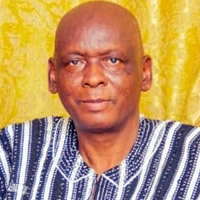
Introduction
Literacy is defined as the ability to read and write a simple statement in any language with understanding. The ability to read and write is essential for the population and for the nation as literacy not only enables people to access information on all spheres of life but also enhances their ability to use it to enhance socio-economic development.
Table 7.1 shows the percentage distribution of the population 15 years and older, by sex and literacy status. The table indicates that more than a half of the population (59.5%) in Upper West Region were not literate. This is more than twice as high as the national average of 25.9 percent. The data also indicate that less than one-fourth of the population were literate in English and a Ghanaian language while about 15 percent were literate in English language only. The level of literacy was higher for males (49.5%) than for females (33.5%). The data further showed that the proportion of males (51.5%) and females (66.5%) who are not literate is far higher than the national average of 19.8 percent males and 31.5 percent of females.
Literacy data at the district level showed that 74.8 percent of the population aged 15 years and older are illiterate, which is much higher than the regional average of 59.5 percent. In six out of the nine districts (Wa West 70.6%; Wa East 74.8%; Sissala East 63.4%; Jirapa 62.0%; Sissala West 67.6%; and Lambussie Karni 62.8%), the illiteracy levels are higher than the regional average of 59.5 percent. The district with the lowest proportion of illiteracy is Wa Municipal (38.0%). Illiteracy for the male and female population is highest in Wa East (69.6% of males and 79.9% of females) and lowest in Wa Municipal (28.1% of males and 47.6% of females).
Table 7.2 shows the age-specific literacy rate among household heads. The table shows that 14.2 percent of household heads (50-59 years) are literate. The least literate group are household heads in the age group 15-19 years (0.7%).
The highest proportion of literacy among male heads is 24.6 percent for those aged 50-59 years and 5.5 percent among female household heads aged 50-59 years. Overall literacy is low and is lower among females than males.
The 2010 Population and Housing Census (PHC) states that education refers to someone “who has had a full-time education in an educational institution”. The person should spend “at least four hours a day receiving general education in which the emphasis is not on vocational skill or trade training”. The 2010 PHC collected information on school attendance for those who are attending or have attended school before, the highest level attended and the highest grade completed. Question asked were from persons aged 6 years or older.
Table 7.3 shows that slightly more than a third (33.5%) of the population 6 years and older had primary school education, while almost one fifth had junior high school education. The proportion with senior high education was 12.9 percent, while 4.3 percent had vocational/technical education and 2.7 percent had a bachelor?s degree.
At the district level, a little over half (54.0%) in Wa East had primary school education, which was the highest in the region. Wa Municipal recorded the lowest percentage (22.2%) of those who had attained primary school level education. Sissala West recorded the highest percentage (22.3%) of those who had attained JSS/JHS education. Sissala East with 16.2 percent, closely followed by Wa Municipal at 16.1 percent, had the highest proportion of people at SSS/SHS level of education. Wa Municipal with 5.4 percent also had the highest proportion of those who had attained a bachelor?s degree, double the regional average of 2.7 percent.
Level of Education and Employment Status
Table 7.4 shows that whereas 53.6 percent of the population 15 years and older were self-employed without employee(s), 33.9 percent were contributing family workers. The proportion of self-employed without employee(s) among the never attended school category was 60.2 percent, which was higher than the regional average of 53.6 percent. The proportion of self-employed without employee(s) was also high (44.3%) for those attaining the vocational/technical/commercial educational level.
The proportion of self-employed without employees was low for those with degree or higher education (6.6%) but large for those who never attended school (60.2%) and those with vocational/technical/commercial education (44.3%). In contrasts, the proportion of employees was highest among those with a degree or higher (88.0%), post-secondary diploma (79.2%) and post-middle/secondary certificate (73.0%). Self-employed with employees was highest (4.9%) among those with vocational/technical/commercial education and lowest (1.3%) among those with post-middle/secondary certificate.
Table 7.5 shows the percentage distribution of population 15+ by education, employment, status and sex. Overall, a higher percentage (70.7%) of males was self-employed without employee(s) among those who have never attended school compared to females (52.3%). Generally, the higher the level of education, the lower the proportion of self-employed without employees, an observation that is true for both males and females.
Among the various educational groups, the proportion of self-employed without employee(s) was high for those who had never attended school (70.7%). The proportion of females engaged as employees was higher than that of males across levels of education. For example, the proportion of females with degree or higher education (88.8%) engaged as employees was higher than for similarly qualified males (87.8%). This was also the case for those with post-secondary and diploma, and post middle/secondary education.
Education and Occupation
Table 7.6 shows that in the 15 year and older workforce, about 80.0 percent of those who had never been to school were skilled agricultural, forestry and fishery workers. They also constituted 67.4 percent and 50.0 percent of those with basic and secondary education. Skilled agricultural, forestry and fishery workers formed 72.8 percent of the workforce, by far the biggest segment, followed by workers in crafts and related trades (10.4%) and in service and sales (7.5%). Those with degrees or higher educational level were less likely to be employed in agricultural forestry and fishery (6.0%) whereas 15.3 percent of those in managerial positions and 55.9 percent of professionals had degrees or higher education
Table 7.7 shows the percentage distribution of population 15 years and older by level of education, occupation and sex. Overall, skilled agricultural forestry and fishery workers formed the largest proportion of the male labour force (77.8%) and of the female labour force (68.3%). The proportion of skilled agricultural forestry and fishery workers that never attended school was 88.5 percent for males and 73.8 percent for females. The proportion was lower for both sexes the higher their level of education.
Among male managers, 6.9 percent and 15.8 percent had post-secondary diplomas or degree and higher respectively, while among females the corresponding proportions were 4.9 percent and 13.1 percent. Interestingly, a higher proportion of women with post-secondary diplomas (55.1%) or degrees and higher (64.6%) were professionals than the proportion of men with the same qualifications (50.6% and 53.9% respectively
Education
The question on literacy referred to the respondent's ability to read and write in any language. A person was considered literate if he/she could read and write a simple statement with understanding. The question on literacy was asked only of persons 11 years and older.
School Attendance
Data were collected on school attendance for all persons three (3) years and older. School attendance refers to whether a person has ever attended, was currently attending or has never attended school. In the census, school meant an educational institution where a person received at least four hours of formal education.
Although the lower age limit of formal education is six years for primary one, eligibility for the school attendance question was lowered to three years because pre-school education has become an important phenomenon in the country.
Level of Education
Level of education refers to the highest level of formal school that a person ever attended or was attending. This information was obtained for persons 3 years and older.
Activity Status
Activity status refers to economic or non-economic activity of respondents during the 7 days preceding census night. Information on type of activity was collected on persons 5 years and older. A person was regarded as economically active if they:
a. Worked for pay or profit or family gain for at least 1 hour within the 7 days preceding Census Night. This included persons who were in paid employment or self- employment or contributing family workers.
b. Did not work, but had a job to return to.
c. Were unemployed.
The economically not active were persons who did not work and were not seeking for work. They were classified by reason of not being economically active. Economically not active persons included homemakers, students, retired persons, the disabled and persons who were unable to work due to their age or ill-health.
Occupation
This referred to the type of work the person was engaged in at the establishment where he/she worked. This was asked only of persons 5 years and older who worked 7 days before the census night, and those who did not work but had a job to return to as well as those unemployed who had worked before. All persons who worked during the 7 days before the census night were classified by the kind of work they were engaged in.
The emphasis was on the work the person did during the reference period and not what he/she was trained to do. For those who did not work but had a job to return to, their occupation was the job they would go back to after the period of absence. Also, for persons who had worked before and were seeking for work and available for work, their occupation was on the last work they did before becoming unemployed. If a person was engaged in more than one occupation, only the main one was considered.
Date Created : 11/28/2017 8:31:44 AM












 facebook
facebook
 twitter
twitter
 Youtube
Youtube
 +233 593 831 280
+233 593 831 280 0800 430 430
0800 430 430 GPS: GE-231-4383
GPS: GE-231-4383 info@ghanadistricts.com
info@ghanadistricts.com Box GP1044, Accra, Ghana
Box GP1044, Accra, Ghana